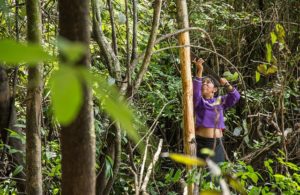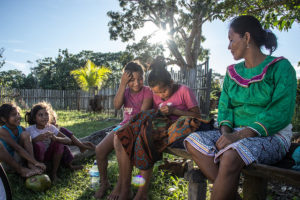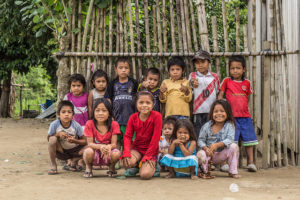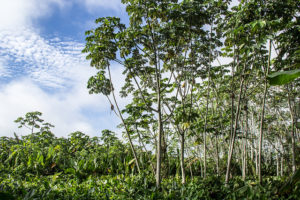To legally obtain title to their community lands, indigenous people in the Peruvian Amazon must navigate a maze of legal paperwork and technical steps that can take as long as a decade to complete.
Research by the Centre for International Forestry Research (CIFOR) found that the process is challenging not only for villagers, but also for government officials.
Lack of coordination among the many government agencies involved, conflicts over rights and boundaries, and the high cost of conducting technical studies, such as mapping community boundaries, were among the difficulties reported.
Underlying those obstacles are differences in the way indigenous people and government agencies understand territorial rights, said Iliana Monterroso, a CIFOR scientist, who led the research.
“Differing expectations, tight budgets and difficulties in coordination among government agencies are the main obstacles mentioned by those interviewed,” she said of the study, which surveyed 32 national and regional government officials.
The researchers examined two ongoing tenure reform processes in Peru targeting native communities. One involves changes in laws that recognize land rights, while the other involves rights to forests, including promoting access to forest resources and support for forest management.
“While the government perceived them as two different sets of regulations, with different institutions responsible for implementation, indigenous communities saw them as a group of measures that should ensure protection of their territorial rights,” said Monterroso.
The study also underscored differences between the way national and sub-national government officials view tenure reform. While those working for the national government see reforms as a way to formalize land rights, regional officers see them as a way to increase access and use of resources to support livelihoods for native communities.
“Besides incongruences in how regulations are perceived, these results also point to a need for greater coordination and communication between the different levels of government,” Monterroso said.
Read also: Reclaiming collective rights: land and forest tenure reforms in Peru (1960-2016)

Shared responsibility, different expectations
Granting legal land titles was initially implemented by Peru’s central government. With the dawn of decentralization in the early 2000s, Lima handed regional governments responsibility – under national guidelines and provision – for boundary demarcation, titling communal lands, and the granting of usufruct rights to forests.
Peruvian law considers all forest lands as public; indigenous communities bid therefore for titles on communal lands classed as agriculture and usufruct contracts for those as forests.
The process involves more than 20 steps and at least a dozen government agencies, both national and regional.
Overall, 60 percent of the government officials involved in implementing tenure reform, including recognition of rights to both land and forests, work at the sub-national level, Monterroso said.
Those officials generally have a significant level of education and experience. 90 percent of those surveyed had a university education, as well as averaging 10 years of work experience.
But working with indigenous communities poses particular challenges for government officials – nearly two-thirds mentioned indigenous communities or cultural norms as a stumbling block when implementing tenure reforms.
“They have the skills necessary for the administrative work, but can lack the cultural understanding needed when titling native communities,” Monterroso said. “Working in an intercultural environment requires the ability to recognize the needs of indigenous communities and how best to go about helping to resolve conflicts.”
Conflicts are not uncommon. When officials were asked about the main obstacles they encountered in the titling process, boundary disputes were mentioned most often, followed by illegal logging, overlapping permits for use of resources, and inefficient management of finances.
Around 40 percent then went on to say that their work involved educating communities about their rights, and the channels available to them to file complaints, but only six percent said they are directly involved in helping to resolve conflicts.
Previous research has shown that while Peru has a high level of conflict over land rights, a relatively small percentage of government officials report that is part of their responsibilities; this is a clear weakness in Peru’s legal system for titling.
Read also: Gender and formalization of native communities in the Peruvian Amazon
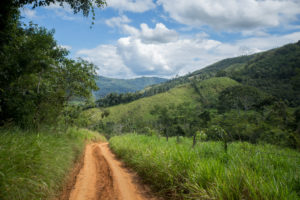
Budgets and coordination are key
More than one-third of the government officials surveyed mentioned inadequate budgets as a significant obstacle to implementation of tenure reform.
Although titling is free for communities, the process is expensive for subnational governments because of the cost of transporting teams to remote areas. As a matter devolved, they therefore have to allocate from their budget assigned from the national Ministry of Economy and Finance, or use contributions from international cooperation agencies.
Costs could range as high as USD 10,000 or more for a single title, depending on the location, the amount of work required, and how long the process takes. Titling takes an average of eight years, although some communities have been waiting for their title for several decades.
“Limitations affecting implementation are mainly associated with inadequate budgets, inefficient communication among the various government agencies involved, and cumbersome procedures,” said Monterroso. “Despite this, overall the respondents had a positive view of how well tenure reform was being implemented.”
The study points to several ways in which the process could be made more effective, she said.
Officials responsible for implementing tenure reform should be prepared to work with indigenous communities and be sensitive to the views of women and young people.
Indigenous communities and government officials often have different understandings of land tenure, so they also must address diverse and sometimes contradictory views about forest and land management and conservation, said Monterroso.
Because the process involves allocating budgets and responsibilities among a minimum of 12 government agencies, it is not surprising officials were in agreement that inter-agency collaboration and coordination are key to making reforms successful.
That’s why Monterroso is calling for additional measures to facilitate better access and exchange of information to not only increase coordination among national and regional government agencies, but to “have a cost-effective way to advance tenure reform implementation.”
She added, “most importantly everyone involved must keep in mind that the role of the state is not simply to grant the community a land title, but to ensure that the resources in the territory can provide the inhabitants with a sustainable livelihood.
“Titling is just the first step.”
By Barbara Fraser, originally published at CIFOR’s Forests News.
This study is part of the CGIAR Research Program on Forests, Trees and Agroforestry (FTA), and is supported by the European Commission, the International Fund for Agricultural Development, the U.N. Food and Agriculture Organization, the Global Environment Facility, and the CGIAR Research Program on Policies, Institutions and Markets.
FTA is the world’s largest research for development program to enhance the role of forests, trees and agroforestry in sustainable development and food security and to address climate change. CIFOR leads FTA in partnership with Bioversity International, CATIE, CIRAD, ICRAF, INBAR and TBI. FTA’s work is supported by the CGIAR Trust Fund.












